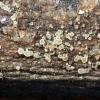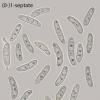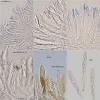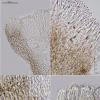
10-09-2025 23:53
 Marcel Heyligen
Marcel Heyligen
Found on Robinia pseudoacasia together with Diapor

11-09-2025 16:57
Our revision of Marthamycetales (Leotiomycetes) is

10-09-2025 17:18
 Blasco Rafael
Blasco Rafael
Hola, encontre este estiercol de vaca estos apotec

02-09-2025 11:34
Thomas Læssøehttps://svampe.databasen.org/observations/10527903

03-09-2025 21:59
Philippe PELLICIERLa Léchère, Col de la Madeleine, alt 1970m, au s

07-09-2025 11:34
 Zuzana Sochorová (Egertová)
Zuzana Sochorová (Egertová)
Hello,I have identified this fungus as Hymenoscyph
Mollisia on Cornus
Enrique Rubio,
22-11-2019 09:41
This Mollisia grew on corticated branches of Cornus, 2 cm thick, lying on the ground. The apothecia are minute, coalescent, whitish, amber colour or grayish when old.
The ascospore are (0-)1-septate, even inside the living asci, arising from croziers, with an apical pore dirty red, rb, even after NH4OH-pret. (I didn't have KOH to do it).
The paraphyses, as the narrowly clavate marginal cells, have somewhat inconspicuous refractive VBs that stain in cresyl blue. Ectal excipulum with pale brownish textura angularis.
Do you have any ideas that might help me?
Michel Hairaud,
22-11-2019 10:29

Re : Mollisia on Cornus
Bonjour Enrique,
The macro suggests that there would be a short stipe and the excipulum has some prismatica textura , at least under the margin. My first guess would go for a Calycina. Did you exclude this genus ?
Amitiés.
Michel
Enrique Rubio,
22-11-2019 10:54
Re : Mollisia on Cornus
Bonjour Michel
Non. Je n'exclude pas Calycina. Je pense que c'est une bonne alternative. Mais l'excípulum est formé par des cellules plutôt polygonales, seulement plus prismatiques vers les flancs de la fructification. Et en plus, tout l'excípulum possède pigmentation et pas seulement la partie la plus basale du même, comme il arrive habituellement en Calycina.
Non. Je n'exclude pas Calycina. Je pense que c'est une bonne alternative. Mais l'excípulum est formé par des cellules plutôt polygonales, seulement plus prismatiques vers les flancs de la fructification. Et en plus, tout l'excípulum possède pigmentation et pas seulement la partie la plus basale du même, comme il arrive habituellement en Calycina.
Andreas Gminder,
22-11-2019 11:28

Re : Mollisia on Cornus
Hello,
I would exclude Mollisia, because the shape of the vacuoles in the paraphyses does not fit Mollisia and also the spores bearing conidia is in my experience not known in Mollisia. The excipular structure doesn't fit well too.
Calycina would also be my first choice to search.
best regards,
Andreas
I would exclude Mollisia, because the shape of the vacuoles in the paraphyses does not fit Mollisia and also the spores bearing conidia is in my experience not known in Mollisia. The excipular structure doesn't fit well too.
Calycina would also be my first choice to search.
best regards,
Andreas
Thomas Læssøe,
22-11-2019 14:00
Re : Mollisia on Cornus
spore shape as in C. vulgaris
Hans-Otto Baral,
22-11-2019 15:32

Re : Mollisia on Cornus
Enrique, could you please send me the plates in higher resolution? I wonder about the browinsh excipulum.
Hans-Otto Baral,
22-11-2019 20:30

Re : Mollisia on Cornus
Now, I am not sure about this fungus. No Mollisia I agree. Pezizellaceae is possible. I finally placed it in Leptodontidium, as it seems to resemble finds that are there in the folder carneum. In that folder I have what I earlier identified as Phaeohelotium subcarneum, with hemiamyloid apical rings.
Enrique Rubio,
22-11-2019 20:42
Re : Mollisia on Cornus
Thank you, Zotto
Do you have literature on Leptodontidium? For example the generic definition of the genus, Leptodontidium de Hoog, that seems to be in Taxon 28(4): 347 (1979)
Do you have literature on Leptodontidium? For example the generic definition of the genus, Leptodontidium de Hoog, that seems to be in Taxon 28(4): 347 (1979)
Hans-Otto Baral,
22-11-2019 21:42

Re : Mollisia on Cornus
You must be aware that the genus was erected for a couple of anamorphs, and it was DNA by which I discovered that Phaeohelotium trabinellum is the teleomorph of L. elatius. These anamorphs are inconspicuous brown setae with minute phialoconidia. This group is a field for future work, and without further DNA tests I fear we will not solve it.





